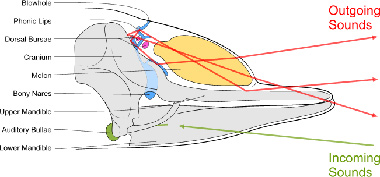Dolphins are some of the smartest animals on the planet. So when it comes to finding its way through the water, it’s not surprising that a dolphin uses the ol’ melon. In this case, we mean it literally. There’s a structure in the dolphin’s head that’s called a “melon.” It produces sounds that the dolphin uses to locate food, predators, and other objects in its path.
 Diagram of sound production and reception in a toothed whale. Credit: Wikipedia
Diagram of sound production and reception in a toothed whale. Credit: WikipediaLike bats, dolphins use “echolocation” to help plot their way through their environment. It’s like sonar -- a series of high-frequency sounds. The sounds strike objects in the water and reflect back to the dolphin. From this echo, the dolphin can locate an object, determine what it is, and even figure out how it’s moving.
The sounds consist of a series of clicks, with each click lasting about one ten-thousandth of a second. The melon focuses the clicks into a beam that projects ahead of the dolphin.
When the sound returns, it strikes the dolphin’s jawbone, which contains special cavities that are filled with fat. The sound travels through the jaw into the dolphin’s ear, which transmits a signal to the brain, which tells the dolphin what’s in its path.
The system is quite sensitive. Bottlenose dolphins, for example, can identify an object as small as the tip of your thumb at a distance of more than 200 feet. They can easily determine a target’s size, its shape, its structure, and even what it’s made of.
Now that’s using the old melon.

